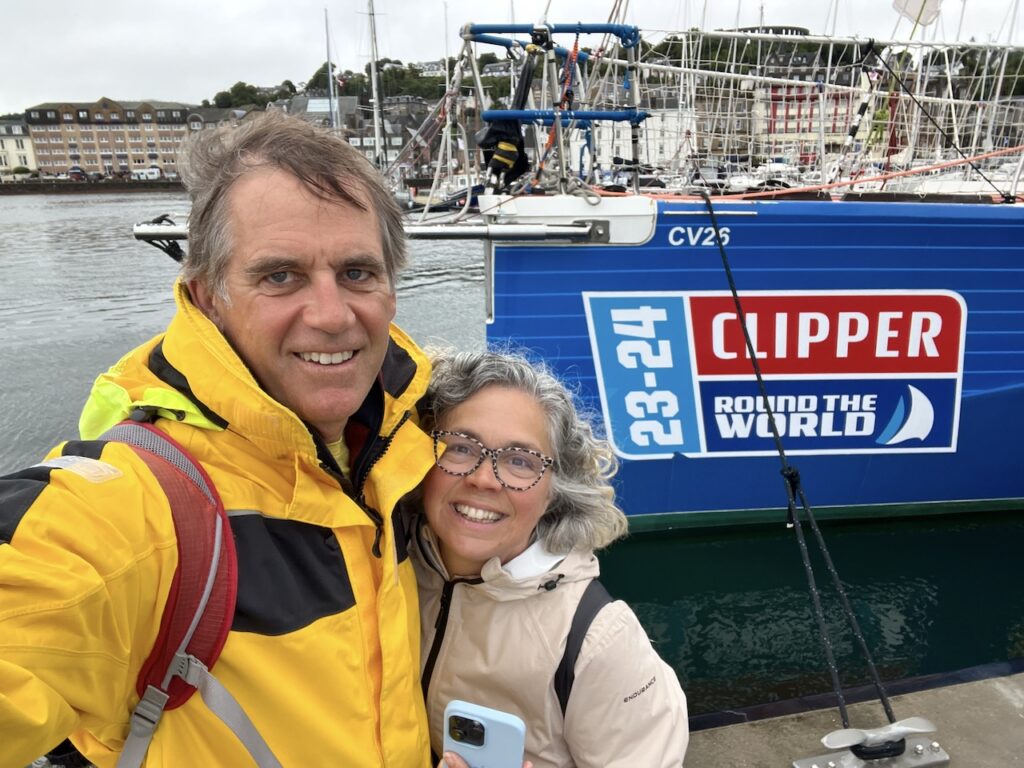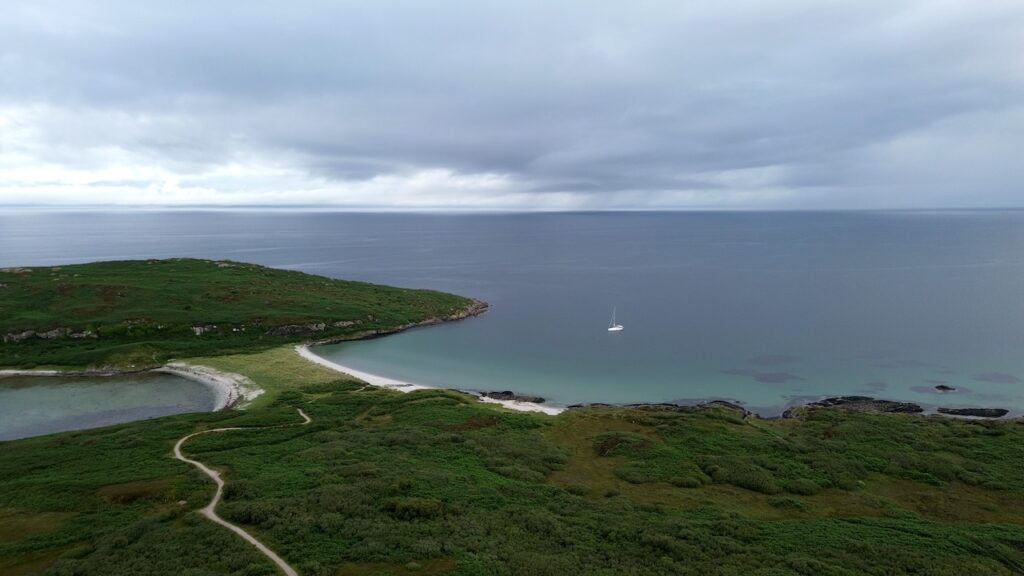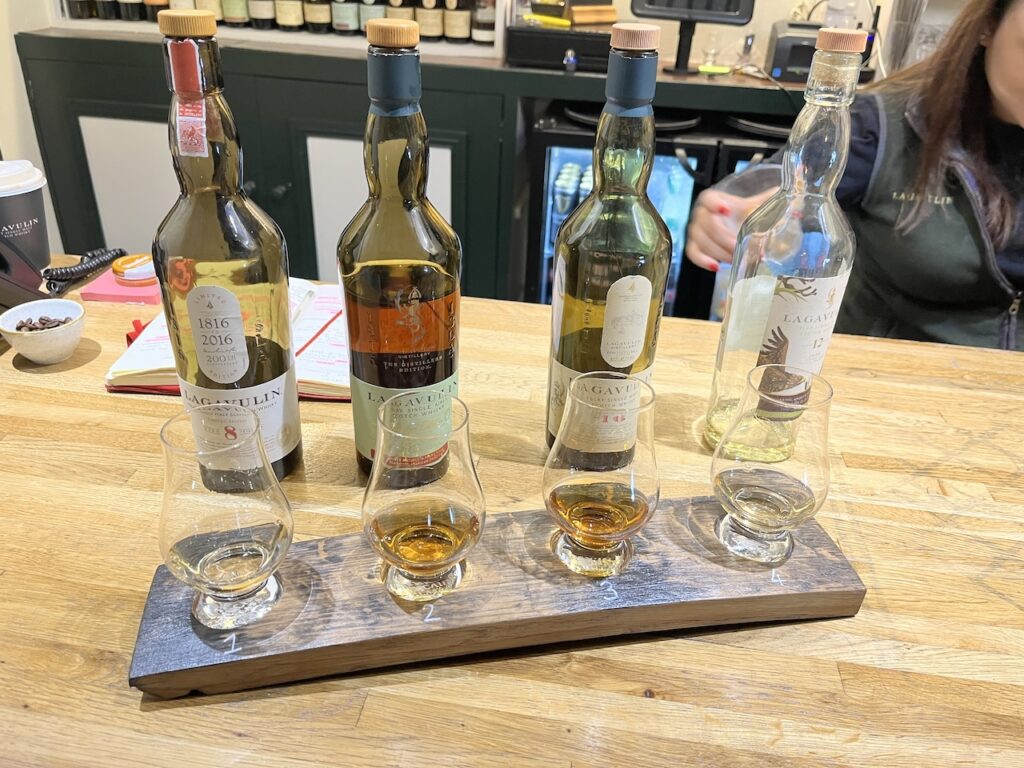At 23, wrapping up an engineering degree and, in my parent’s view, possessing all of the skills to shake up the corporate world, make lots of money, and release my parents from their state of worry, my wayward intentions caused a bit of a fright. I wanted to cross an ocean, and in truth, I wanted to keep going around the world. It’s a good thing for my parent’s sanity that the Clipper Round the World race had yet to be conceived. This race, comprised of eight legs across the globe, had chosen the port of Oban as the start of it’s last leg enroute to Portsmouth, UK. We had to be back in Oban anyway to welcome onboard our friends Dave and Suzy for a week of Scottish sailing and culture. The chance to view the start of this epic race was a cherry on the top. Eleven boats have been competing since the race started in September 2023 and each crew sails on an identical boat, a custom built 70 foot racing machine led by a professional skipper and first mate. The remainder of the 22 person crew is comprised of amateur sailors paying their way – up to $70,000 for the complete journey. That price might have been a serious reality check for 23 year old me. I know I wasn’t the only one with a fitful start to young adulthood; somewhere along the way I found myself working a respectable job, making money and extending the life expectancy of my parents. Still it would have been an amazing experience to skipper one of these go-fast boats.


At a pace that ensured no race skipper would feel threatened, we put Oban to our stern and headed south in search of a place for the night. Dave and Suzy had been in country for a week and were well acclimatized, but we still wanted to follow our rule of a mellow first day on the water for our guests. We chose the mouthful of a harbor named Puilladibraihn, reported by some sailors as the most beautiful of Scotland. The only problem was the lack of room. We squeezed in and dropped our anchor on a short scope with a drama-inducing nine other boats already having done the same. To land the dinghy meant stepping out into the muddy muck of a low-tide shore, but after a little tidying up, we set out on a hike for the tantalizingly named Bridge Across The Atlantic. While this humped stone bridge, built in 1793, was indeed attractive, the real reason someone should come to these parts is the even better named Tigh an Truish, which the barmaid happily translated for us as ‘House of the Trousers’. Now, before you go down the path of scandalous affairs of the Kinloch Castle ilk, the name arose from the period immediately after the Jacobite Rebellion when it was illegal to wear a kilt. Islanders, before crossing the bridge to the mainland would swap out their kilt for trousers. Sounds innocent enough on paper, right?!


With the anchorage at Puilladibraihn at capacity, and much to see for the week, we chose to push on, particularly due to a favorable current in the Sound of Luing, a tight squeeze between islands where the current accelerates to speeds that can’t be overcome with a sailboat-sized engine. As the daylight started to fade, we found ourselves on the positive side of a 4-5 knot current. Swirls and pooling of water from lower depths confirmed the power of the tidal stream here, as we watched the shoreline close to our port side disappear quickly past our stern, almost like how it must feel on a powerboat. Two high speed inflatables, the kinds with big twin outboards and dual rows of saddle seats with grab bars for passengers, all dressed in the tour company-issued black full body foul weather suits, raced by us. Shortly, the reason became clear. To our starboard side, a break between Scarba and Jura Islands – the Gulf of Corryvreckan – was spilling huge volumes of water across our path. Onshore a day later, I found the tour boat company’s brochure offering views of big whirlpools at Corryvreckan. For now, we had to crab sideways to hold our course to our chosen anchorage on Jura. Our chartplotter was telling us the sideways current was increasing, starting at 4, then 5 knots and higher. Finally, when we were fully exposed to the opening at Corryvreckan, we had a whopping 8 knots of current pushing us sideways, placing us at great risk of being swept past our anchorage. It was dusk and we really needed to get settled for the night. We were also breaking our rule of a low-drama first day with guests. We revved the engine to the highest RPM’s we were comfortable with and pointed the bow directly towards the shore. Finally, as we slowly moved out of the peak of the flow, hope was restored that we could settle into a mode of preparing to anchor. When we have been in high tidal current areas before, we have tried to time it for at least some amount of favorable current, but this huge amount of sideways flow was a first for us.

The coastline in this part of Scotland has long inlets that cut deep into the interior. To see them all would involve a lot of time motoring up and down windless passageways. But right across from our anchorage of Jura was the modestly long Loch Sween, named after the much deteriorated Castle Sween. Or perhaps the castle was named after the loch. Regardless, we pulled into the town at Tayvallich, with the choice of an outer and inner harbor, separated by a long natural breakwater. Joining us in the security of the inner harbor was an old cargo vessel we had seen chugging up Loch Sween earlier in the day looking quite odd given the amount of smoke it was emitting into the air on this crystal clear blue sky day. It was like the large billowing clouds arising from an old steam locomotive, except these clouds were pitch black instead of innocent white. When VIC-32, the last active Clyde Puffer tossed out its old fisherman’s anchor next to us, we witnessed firsthand the source of the black soot – a coal-fired steamship. She had swapped cargo for passengers as an old vintage tour boat on a one week turn. I’m all about preserving maritime history, but this heavily polluting craft should be in a museum somewhere, saving the environment from the emissions equivalent of at least 20 modern boats of it’s size, and perhaps many more.
Tayvallich is a fine town for a stroll through the relatively flat countryside, and we ran into several crews on other sailboats, including one from Chicago, where the information exchange comes about rapidly and in earnest, as if we were both pilgrims, one headed west, the other east over a vast and desolate desert. Fortunately, Tayvallich was far from a desert, in fact the home of fine desserts and other delectables as we dined out at the exquisite Tayvallich Inn, followed by a civilized evening of cribbage play – well, civilized until you ply your opposing team with extra drams of the local peat-smoked whiskey. All is fair in love and war!


One of the attractive features of sailing in Western Scotland is the close proximity of anchorages and marinas. Once we were clear of Loch Sween, it was an easy 10 mile sail back across to the island of Jura with a strong breeze, flat water, and clear views of ‘The Paps’ mountains, landmarks that easily distinguish Jura from it’s neighbors. Just below The Paps is the harbour of Craighouse. I have no idea who Craig is or was, but these days it is most popular as the home of Jura whiskey. I knew painfully little about whiskey before this excursion into Scotland, and Jura, the largest producer of single malt scotch whiskey, was a good place to start. With their high end bottle coming in at 1500 £, the distillery commonly hosted a more well-heeled guest list than our rag-tag crew of sailors, evidenced by the regular landings in the harbor of a seaplane, flown by a pilot who seemed to have no issue taking off again between the masts of the anchored sailboats.




Like I mentioned, anchorages are a-plenty in this region, and ten miles of sailing back across the Sound brought us to the northern tip of Gigha Island where we joined one other boat in relative isolation off of a sandy beach. To our surprise, the other boat was our friends Mike and Marge from True North. As we were catching up, a tiny dilapidated sailboat with a long brown stain on it’s starboard side, looking like it had laid abandoned on it’s side in the muck of a bog for a few too many years, came put-putting into the anchorage. It had been a windy crossing for us and I couldn’t imagine this boat, with whispy, moldy, threadbare cloth for sails could have made it from any of the neighboring harbours. The solo captain came uncomfortably close to the rocks and slithered up to the bow to toss over a small anchor on a line with no weight-inducing chain. Sure enough, over the next hour, he slowly slide downwind past our friends and out into deep water. I don’t mean to be insensitive. I had some pretty homey looking sailboats in my past. But putting yourself and those around you at risk, and eventually requiring the coast guard to put their people at risk, becomes a selfish pursuit. He eventually re-anchored and we carefully eyed his position before considering it safe to go ashore for a much need long walk.
On the other end of the island was the only settlement of any measure – a micro-sized grocery store that doubled as the post office, plus a bulletin board and a take one-leave one sharing library, all watched over carefully by a proprietor that, if asked, probably knew everything, including every scandal, on the island. Across the street was the charmingly-named Wee Isle Cafe, whose products were sourced from the same grazing diary cows we had walked by on the way down from the north. I am a sucker for anything loosely related to baked items. If I’m ever a victim of a scam artist, it will likely be based on discovering a weak point of entry using flour, sugar, salt and butter. In the display case were two lonely scones passed over by previous patrons. If you’ve ever been to Ireland, you know the kind of puffed up scone with the top tilting over as if on a bender from the previous night’s whiskey incursion. We accepted the kind woman’s offer to warm them up. The serving of a scone is a big affair for a measly three euros. They will place them on a wide plate with (more) butter, a jam of your choice, and in many parts, an overly generous tub of clotted cream, which, if you look at the overall ingredient intake, is like mainlining cream, cream and cream. For a moment, brief as it were, I was missing my California roots and their avocado toast!

While it is overflowing with interesting and unique anchorages, this area of the Scottish coast is not the most convenient for crew getting on and off the boat. Dave and Suzy had wisely chosen to take a island hopper plane from Port Ellen back to Glasgow, for their Atlantic hopping flight home to Boston, instead of a six hour ferry and overland bus adventure. Port Ellen was back across the Sound once again. I felt at one point like we were one of those wooden shuttles used in a loom to pass thread back and forth. I hoped that the tapestry we had been weaving for the week would be noteworthy enough that our friends would find it compelling to return aboard soon.
Port Ellen, on the island of Islay, juts out on the end of a row of Scottish islands right close to the coast of Northern Island. In fact, on a clear day, you can see a faint outline of the Irish coast. With it’s geographically desirable location, the ferry traffic – the tall, girthy ones with a belly full of cars – are coming and going nearly continuously at Port Ellen. After a slow but steady sail across from Gigha, we furled sails and motored past the ferry, being careful to not let it’s propellor wash send us out of the narrow channel, outside of the dredged area and into the water shallow enough that you could walk out to the channel buoys at low tide – that is, if you don’t mind brown muck suctioning your feet into submission. Port Ellen has a centrally located marina watched over by a harbour master who, despite his part-time hours, appeared to care deeply that every one – local and visitor alike – were well cared for. Boats kept coming in after our arrival, and he seemed to magically find accommodation for them all, like having Christmas dinner at grandma’s where more chairs can always be rustled up seemingly out of thin air.
On about a weekly turn, we have a not-insignificant list of practical choirs to conquer, including laundry, groceries, diesel and if we are really lucky, a fresh long hot shower ashore. Around these parts, diesel fuel is the biggest challenge of all. For some reason, marinas don’t commonly have a fuel docks. Nor, despite the prevalence of large scale fishing, are there commercial fuel sources. It explained why we didn’t see many powerboats around and those that we did see were idling along at fuel-sipping speed. The only option available, and commonly recommended in the cruising guides, was the walking of jerry cans to a local gas station. We didn’t have jerry cans nor did we fancy making the many trips to replace 100-150 liters at a time. But, we had no choice. By good fortune, the local gas station a ten minute walk away provided a 20 liter loaner can and a trolley to roll it down the road. From Port Ellen, we had a long trek down the west coast of Ireland ahead of us, where there were even fewer fuel dock options, so it was critical that we top up. Dave and I headed off to the gas station feeling quite positive, like we were off to live-life-like-the-locals kind of skip in our step. In the end, after two trips and a horrific experience trying to pour diesel out of the top of a jerry can with no spout into a deck fill below with a make-shift wobbly funnel, we concluded our experience with diesel all over our hands and forearms, on the deck and, regrettably, too much down the scupper and into the harbor. How I missed the self-service fuel docks throughout Scandinavia. But like soon forgetting the pain of childbirth, we shared a last dinner out together before returning to the boat, only loosely aware of how our laughter at an embarrassing game of cribbage must have reaffirmed our boat neighbor’s concern about overly social American tourists!
In the morning, with a little smidgen of unexpected free time, we walked the ‘Three Distilleries Path’ which, on account of recent construction, should have be renamed ‘Five Distilleries If You Dare Path’. The original three, including the two we visited – Laphroaig and Lagavulin – have great big black lettering against a field of white facing the sea. I found it endearing they would make sure a huge effort to advertise their existence to the sailors passing by. Clearly, their efforts were successfully with these four sailors!




In the meantime, be sure to check out our latest YouTube video release of our Norway adventures from last summer… this time, as we round the notorious Stad peninsula!



Such a great documentary and synopsis of our special week together. Thank you for your friendship and adventurous spirit!
Dave and Suzy
So glad we were able to find a week to share together in these busy times in our lives! All of our love to you both!